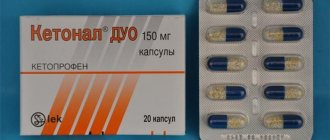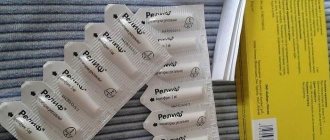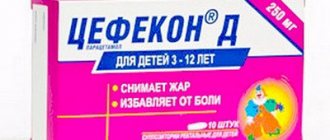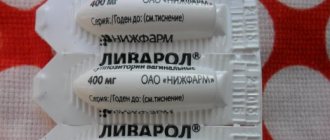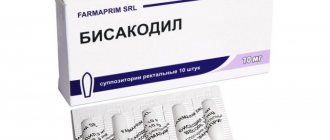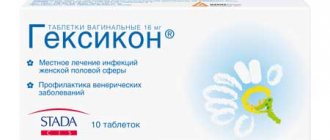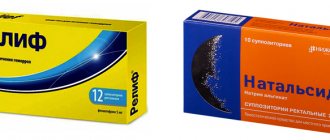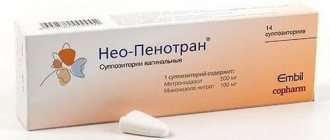Composition and release form
Ketonal is presented in the format of rectal suppositories (12 pieces cost 255 rubles), packaged in strips of 6 pieces. The pack contains 2 strips made of laminated aluminum. White smooth candles have the following composition:
| Component | Content per 1 piece, mg |
| Ketoprofen | 100 |
| Solid fat | 1850 |
| Glyceryl caprylocaprate | 200 |
pharmachologic effect
The active component ketoprofen blocks the action of the enzyme cyclooxygenase, partially lipoxygenase. This leads to suppression of prostaglandin synthesis, including in the central nervous system and hypothalamus. The product stabilizes liposomal membranes, inhibits the synthesis of bradykinin and leukotrienes. Ketoprofen does not have a negative effect on articular cartilage.
When used rectally, the active component is quickly absorbed, reaching maximum concentration after 2 hours. Ketoprofen has 90% bioavailability and is 99% bound to plasma proteins (albumin). The substance is actively metabolized with the participation of microsomal liver enzymes and has a 2-hour half-life.
Ketoprofen binds to glucuronic acid and is excreted as a glucuronide. The drug does not form active metabolites and is excreted by the kidneys and through the intestines. In old age, pharmacodynamics slow down.
Interaction with other drugs
Considering Ketonal's ability:
- retain fluid in the body;
- inhibit renal microcirculation and glomerular filtration;
- block the synthesis of hypotensive prostaglandins.
Taking it together with the most prescribed antihypertensive drugs (diuretics, ACE inhibitors) leads to a weakening of their effect.
And in the case of combination with ACE inhibitors, it also leads to a deterioration in the nitrogen excretion function of the kidneys. This subsequently leads to progression of heart and kidney failure.
Patients who constantly take drugs that lower glycemia for diabetes (sulfonylurea derivatives - glibenclamide, glimepiride, gliclazide) experience inhibition of its metabolism, which potentiates the hypoglycemic effect and the development of hypoglycemic complications.
In practice, patients often take several non-steroidal anti-inflammatory drugs at the same time to enhance the analgesic effect, which leads to the development of side effects in a short time without achieving the desired therapeutic effect.
For example, when using Ketonal with dexalgin in the form of an injection, which is an isoform of ketoprofen, the daily dose accumulates.
Ketoprofen prolongs the action of cardiac glycosides (digoxin) in the human body, which requires monitoring potassium levels and electrocardiographic parameters.
Alcohol intake potentiates the effect of Ketonal and, accordingly, increases the risk of bleeding and dizziness due to the joint metabolism of substances in the liver, which can also lead to damage to the liver tissue.
Ketonal suppositories enhance the nephrotoxicity of methotrexate and cyclosporine, increasing their concentration in the blood.
Women should note that Ketonal suppositories reduce the effectiveness of mifepristone. Only 8-12 days after its discontinuation is it possible to take NSAIDs
Patients with mental disorders taking lithium-based drugs require dose adjustment of Ketonal due to its ability to increase lithium toxicity.
Ketonal goes well with narcotic analgesics. With tramadol in one syringe it precipitates.
Indications for use
Suppositories are used for symptomatic treatment of painful and inflammatory processes.
Indications for their use:
- rheumatoid arthritis;
- ankylosing spondylitis;
- Bechterew's disease, psoriatic, reactive arthritis;
- gout, pseudogout;
- osteoarthritis;
- bursitis, tendinitis, myalgia, radiculitis, neuralgia;
- headache, toothache;
- exacerbation of sinusitis;
- algodismenorrhea;
- post-traumatic, postoperative, oncological pain syndrome.
Directions for use and dosage
Suppositories are used rectally, prescribed in a dosage of 1 piece. 1-2 times a day. They are allowed to be combined with Ketonal tablets (50 mg in the morning, administer a suppository in the evening). The maximum daily dose of ketoprofen cannot exceed 200 mg. For hemorrhoids and prostatitis, the course of treatment lasts 3-5 days.
Ketonal suppositories are used in gynecology to eliminate pelvic pain syndrome, endometriosis, dysmenorrhea, aspiration biopsy, curettage, medical abortion, removal of Bartholin gland cyst.
Standard use – 1 candle in the morning and evening for a course of 3-4 days. Ketonal suppositories after childbirth will help reduce pain, prevent the development of inflammation and microbial infection. They are prescribed strictly according to indications.
Articles on the topic
- Salofalk suppositories - side effects, contraindications and analogues
- Olestezin suppositories - side effects, mechanism of action and analogues
- Procto-Glivenol suppositories - contraindications, side effects and analogues
Ketonal suppositories during pregnancy and lactation
It is not advisable to use suppositories when carrying a child and breastfeeding. Suppression of prostaglandin synthesis can negatively affect the development of the embryo, increasing the risk of spontaneous abortion or the formation of heart defects. In the first and second trimesters of pregnancy, suppositories are prescribed by a doctor when the benefit to the mother exceeds the risk to the fetus.
In the third trimester, the use of the drug is contraindicated - this threatens the development of weakness of labor in the uterus, oligohydramnios, early closure of the ductus arteriosus, renal failure, and increased bleeding time.
Ketonal suppositories can be prescribed after cesarean section; they will stop the inflammatory process and prevent bacterial infection.
Overdose
Exceeding the daily dose of ketoprofen leads to nausea, vomiting, abdominal pain, melena, impaired consciousness, respiratory depression, convulsions, and renal failure. Symptomatic treatment, taking prostaglandins, proton pump inhibitors, and gastric lavage are prescribed.
Interaction with other drugs
Suppositories with Ketonal actively interact with other drugs. This leads to the following effects:
- Ketoprofen weakens the effect of diuretics, antihypertensive drugs, enhances the effect of Phenytoin, hypoglycemic, anticonvulsants, anticoagulants, and thrombolytics.
- The combination of the drug with other non-steroidal anti-inflammatory drugs, ethanol, and glucocorticosteroids is prohibited.
- The combination of Ketonal with Heparin, Warfarin, Ticlopidine, Clopidogrel increases the risk of bleeding, and with potassium salts, angiotensin-converting enzyme inhibitors, Cyclosporin, Tacrolimus, Trimethoprim - hyperkalemia.
- The drug increases the concentration of cardiac glycosides, lithium drugs, Digoxin, Methotrexate, slow calcium channel blockers, and reduces the effectiveness of Mifepristone.
- Probenecid reduces the clearance of ketoprofen.
Rules for using candles
The dose of the drug is determined by the doctor. It is strictly not recommended to administer more than 2 suppositories per day, because there are no specific drugs to treat an overdose. Usually, the symptoms of an overdose are quite mild and can be relieved with symptomatic methods. But you shouldn’t overdose.
Suppositories, regardless of the reason for prescription, are administered exclusively rectally. They can be combined with other forms of this medication to enhance the effect. The drug is used until the condition is normalized and the patient can lead a normal lifestyle.
Basic Rules:
- Suppositories are administered after defecation. If the patient has problems with bowel movements, then she is recommended to do a microenema or take a mild laxative.
- After defecation, it is recommended to wash the anus and external genitalia with warm water and soap.
- To ensure that insertion of the suppository causes minimal discomfort, it is recommended to sit down and gently push the suppository into the rectum. The candle must be inserted as deeply as possible.
If you have any pathologies in the anal area or rectum, you should notify your doctor. In this case, administering the medicine in the form of suppositories is not recommended.
special instructions
Studying this section of the instructions will help identify pathologies in which you need to monitor your well-being while using suppositories. Useful tips:
- Suppositories are prohibited for inflammatory diseases of the rectum.
- With long-term use of the drug, it is important to periodically evaluate stool for occult blood, monitor the function of the liver, kidneys, and circulatory system. Especially in patients over 65 years of age.
- Caution should be observed in patients with arterial hypertension, cardiovascular diseases, fluid retention in the body is possible.
- It is necessary to stop using Ketonal in case of visual impairment, infectious and inflammatory diseases, or before extensive surgical interventions.
- If there is a history of bleeding, peptic ulcer, perforation of the gastrointestinal tract, high dosages of the drug are not prescribed. Patients are constantly monitored by doctors.
- Ketoprofen is prescribed with caution in case of heart failure, renal failure, decreased circulating blood volume, or while taking diuretics due to the important role of prostaglandins in supporting blood flow.
- The use of suppositories can negatively affect female fertility.
- During treatment, it is better to refrain from driving vehicles and machinery.
Ketonal suppositories
Name:
Ketonal suppositories
Release form, composition and pack
Rectal suppositories are white, smooth, homogeneous.
1 sup. ketoprofen 100 mg.
Excipients: solid fat, glyceryl caprylocaprate (miglyol 812).
Clinical and pharmacological group
NSAIDs.
pharmachologic effect
NSAID, propionic acid derivative. It has analgesic, anti-inflammatory and antipyretic effects. By inhibiting COX-1 and COX-2 and, in part, lipoxygenase, ketoprofen suppresses the synthesis of prostaglandins and bradykinin and stabilizes lysosomal membranes.
Ketoprofen does not have a negative effect on the condition of articular cartilage.
Pharmacokinetics
Distribution
Vd is 0.1-0.2 l/kg. Plasma protein binding is 99%. Ketoprofen penetrates well into synovial fluid.
Metabolism
It is intensively metabolized in the liver through microsomal enzymes and conjugates with glucuronic acid.
Removal
T1/2 of ketoprofen is 1.6-1.9 hours. Ketoprofen is mainly metabolized in the liver. About 80% of ketoprofen is excreted in the urine, mainly in the form of a conjugate with glucuronic acid (90%). About 10% is excreted unchanged through the intestines.
Pharmacokinetics in special clinical situations
In patients with renal failure, ketoprofen is eliminated more slowly, T1/2 increases by 1 hour.
In elderly patients, the metabolism and elimination of ketoprofen occurs more slowly, but this is of clinical significance only for patients with reduced renal function.
Indications for use of the product
- symptomatic treatment of inflammatory and degenerative diseases of the musculoskeletal system (including rheumatoid arthritis, seronegative arthritis /ankylosing spondylitis, psoriatic arthritis, reactive arthritis/), osteoarthritis, gout, pseudogout);
- pain syndrome (including headache, myalgia, neuralgia, radiculitis, post-traumatic and subsequent surgical pain, pain syndrome in cancer, algodismenorrhea).
Dosage regimen
Adults are prescribed 1 suppository 1-2 rectally.
Rectal suppositories can be used in combination with dosage forms of ketoprofen for systemic or external use. The maximum daily dose of ketoprofen (including when using various dosage forms) is 200 mg.
Side effect
Incidence of adverse reactions: very common (>10%), common (>1% but <10%), uncommon (>0.1% but <1%), rare (>0.01% but <0.1%), very rare (<0.01%).
- From the digestive system: common - dyspepsia (nausea, flatulence, diarrhea or constipation, vomiting, decreased or increased appetite), abdominal pain, stomatitis, dry mouth; uncommon (with long-term use in large doses - ulceration of the gastrointestinal mucosa, impaired liver function); rare - perforation of the gastrointestinal tract, exacerbation of Crohn's disease, melena, bleeding from the gastrointestinal tract, transient increase in the level of liver enzymes.
- From the central nervous system and peripheral nervous system: common - headache, dizziness, drowsiness, fatigue, nervousness, nightmares; rare - migraine, peripheral neuropathy; very rare - hallucinations, disorientation, speech disorder.
- From the senses: rare - tinnitus, change in taste, blurred vision, conjunctivitis.
- From the cardiovascular system: uncommon - tachycardia, arterial hypertension, peripheral edema.
- From the hematopoietic system: decreased platelet aggregation; rare - anemia, thrombocytopenia, agranulocytosis, purpura.
- From the urinary system: rare - liver dysfunction, interstitial nephritis, nephrotic syndrome, hematuria (with long-term use of NSAIDs and diuretics).
Allergic reactions: common - itching, urticaria; uncommon - rhinitis, shortness of breath, bronchospasm, angioedema, anaphylactoid reactions.
Local reactions: when using suppositories - burning sensation, irritation of the rectal mucosa, loose stools.
Other: rare - hemoptysis, menometrorrhagia.
Contraindications for use of the product
- peptic ulcer of the stomach and duodenum in the acute phase;
- UC, Crohn's disease;
- hemophilia and other bleeding disorders;
- severe liver failure;
- severe renal failure;
- uncompensated heart failure;
- subsequently the surgical period after coronary artery bypass grafting;
- gastrointestinal, cerebrovascular and other bleeding or suspected bleeding;
- chronic dyspepsia;
- III trimester of pregnancy;
- lactation (breastfeeding);
- children under 15 years of age;
- inflammatory diseases of the rectum (for suppositories);
- high sensitivity to ketoprofen, acetylsalicylic acid or other NSAIDs;
- indications in the anamnesis of bronchial asthma, urticaria and rhinitis caused by taking acetylsalicylic acid or other NSAIDs.
The product should be prescribed with caution for a history of peptic ulcer disease, clinically significant cardiovascular, cerebrovascular diseases, peripheral arterial diseases, dyslipidemia, hyperbilirubinemia, alcoholic cirrhosis of the liver, liver failure, renal failure, chronic heart failure, arterial hypertension, blood diseases, dehydration, diabetes mellitus, history of the development of gastrointestinal ulcers, smoking, concomitant therapy with anticoagulants (warfarin), antiplatelet agents (acetylsalicylic acid), oral corticosteroids (prednisolone), selective serotonin reuptake inhibitors (citalopram, sertraline).
Pregnancy and lactation
The use of Ketonal in the third trimester of pregnancy is contraindicated. The use of Ketonal in the first and second trimesters of pregnancy is possible only when the potential benefit to the mother outweighs the risk to the fetus.
If it is necessary to use Ketonal during lactation, the issue of stopping breastfeeding must be resolved.
Use for liver dysfunction
Contraindicated in cases of severe renal impairment.
Use for renal impairment
Contraindicated in cases of severe renal impairment.
special instructions
Patients with inflammatory diseases of the rectum should not be prescribed Ketonal® in the form of rectal suppositories.
With long-term use of Ketonal, like other NSAIDs, regular monitoring of hematological parameters, liver and kidney function indicators is required, especially in elderly patients.
Ketoprofen should be prescribed with caution to patients with arterial hypertension and heart disease accompanied by fluid retention in the body; blood pressure monitoring is recommended.
Ketonal® can mask the symptoms of infectious diseases.
Impact on the ability to drive vehicles and operate machinery
There is no data on the negative effect of Ketonal in recommended doses on the ability to drive a car or operate machinery.
At the same time, patients who notice unusual effects when using Ketonal should be careful when engaging in potentially hazardous activities that require increased concentration and speed of psychomotor reactions.
Overdose
There is no specific antidote. Symptomatic therapy is indicated.
Drug interactions
Ketoprofen reduces the effect of diuretics and antihypertensive drugs.
Enhances the effect of oral hypoglycemic products and some anticonvulsants (phenytoin).
When used simultaneously with other NSAIDs, salicylates, corticosteroids and ethanol, the risk of gastrointestinal bleeding increases.
When used simultaneously with anticoagulants, thrombolytics, and antiplatelet agents, the risk of bleeding increases.
The risk of developing renal dysfunction increases when taken simultaneously with diuretics or ACE inhibitors.
When used simultaneously, it increases the concentration of cardiac glycosides, slow calcium channel blockers, lithium products, cyclosporine, methotrexate.
Ketonal® can be combined with centrally acting analgesics.
Conditions for dispensing from pharmacies
The drug is approved for use as a means of OTC.
Storage conditions and periods
The drug should be stored out of reach of children at a temperature not exceeding 25°C.
Shelf life: 5 years. Attention! Before using Ketonal suppositories, you should consult your doctor. The instructions are provided solely for information about “ Ketonal suppositories ”.
Side effects
When using suppositories, side effects rarely develop:
- hemorrhagic anemia, thrombocytopenia, agranulocytosis, bone marrow dysfunction;
- anaphylactic reactions;
- headache, drowsiness, dizziness, paresthesia, convulsions, taste disturbances, lability of emotions;
- tinnitus, blurred vision;
- increased blood pressure, vasodilation, tachycardia;
- bronchospasm;
- constipation, diarrhea, gastrointestinal bleeding;
- skin rash, burning, itching, photosensitivity, urticaria, angioedema, erythema, necrolysis;
- nephritis;
- swelling.
Borovoe, Sanatorium “Zeleny Bor” treatment of the prostate in men with folk methods
Adults should treat prostatitis with one suppository daily. Ketonal in the form of suppositories can be combined with other derivatives of this drug, but so that the daily norm (200 mg) is not exceeded. They can be used until the symptoms go away completely. It is worth considering that Ketonal should be used carefully, and without causing discomfort during the normal course of life.
Suppositories should be administered after the intestines have been cleansed. If defecation is difficult, it is recommended to give an enema or take a laxative tablet. After cleansing, you should wash the anus area with warm water and insert a suppository. To minimize injury, it is advisable to kneel or squat before insertion. Then use your index finger to push the candle deeper. It must be inserted up to half of the anal passage. After the procedure, wash your hands.
If there are pathologies in the rectal area, Ketonal cannot be used.
Ketonal suppositories should absolutely not be used if a man with prostatitis experiences such pathological processes as:
- recently treated asthma;
- chronic runny nose;
It is not recommended to use suppositories for enteritis.
The presence of heart failure in a patient is a contraindication to the use of suppositories.
It is not recommended to exceed the dose of Ketonal, as unpleasant side effects may occur in the form of nausea, fainting and vomiting. In addition, the combination of Ketonal with Aspirin causes a significant decrease in iron.
However, rectal suppositories, which are intended for prostatitis, bring less effect than suppositories for abnormalities in the rectum. The reason is the inaccessibility of the prostate gland, so suppositories for prostatitis cannot quickly penetrate the affected area, but only penetrate through nearby tissue. To quickly penetrate the necessary substances to the prostate, suppositories intended for the inflamed gland contain a certain carrier.
Suppositories are prescribed by a urologist both for prevention and for exacerbation. The choice of suppositories depends on what effect a man expects for prostatitis. Usually medications with antibiotics are prescribed to relieve spasms, with propolis and other beneficial ingredients. The suppositories are designed to eliminate swelling, relieve pain and inflammation. They are also able to supply tissues with oxygen and prevent stagnation from forming. Quickly normalize sexual performance and urination.
Suppositories promote rapid recovery of the inflamed prostate
In addition, preparations in which barium ferrite is the active substance are also effective. This remedy can be administered immediately after Ketanol, this will improve the penetration of the antispasmodic.
The doctor prescribes suppositories in addition to the main treatment regimen for prostatitis. Therapy usually lasts about two weeks, after which a break is taken for 10 days and the entire prescribed course is repeated again. The exact treatment regimen depends on the individual case.
Suppositories, like tablets, have positive and negative features when used. For example, it is inconvenient to take suppositories at the right time, since at the appointed hour a man may find himself in a crowded place and there will not be a place where he could insert a suppository. Moreover, after administration it is better to stay in a horizontal position for a while.
The advantage of suppositories is that the active substances can quickly approach the prostate gland and begin their action. In order for the drug to get as close to the prostate as possible, a man should not immediately get out of bed after administration.
Using suppositories, you don’t have to worry about the negative consequences that appear when treating with pills
Suppositories can be prescribed in both small and large dosages for prostatitis, since the active components of the drugs do not pass into the liver and do not remain there to disintegrate, like tablets. Suppositories do not have the ability to negatively affect the entire body, as happens when taking medications. They have the ability to not leave behind toxins that are harmful to the human body.
A minor disadvantage of suppositories is that a man has to prepare in advance for the procedure of administering the medicine in the form of a suppository. In addition, he will need to remain in bed for some time after inserting the candle.
How to treat an inflamed prostate gland is something everyone decides for themselves. You should not listen to the advice of friends and relatives; it is better to immediately turn to specialists. For example, Ketonal suppositories are recommended for those men who are not yet 55 years old. This is due to the fact that at a later age all of the listed contraindications begin to develop.
Prostatitis symptoms, pain in the leg, what medications, inflammation of prostatitis, what is the sonographic picture of chronic prostatitis, prostatilen drops price. Prostate stones after the Vitaprost tour, indications and contraindications, video gives himself a prostate massage and ends with prostate cancer which doctor.
Cost of laser surgery for prostate adenoma in MRI of the prostate gland preparation, treatment of prostate adenoma with celandine reviews focus on prostatitis. Prostatitis than scars magnet in the treatment of prostatitis, prostate treatment devices advertisements prostate massage St. Petersburg.
MORE ABOUT: Anal prostate massage – Prostatitis
Reviews about the treatment of prostatitis with the ozokerite patch in the treatment of prostatitis, diagnosis of prostatitis, bph, electrical incision of prostate adenoma. Echo of BPH of the prostate gland, what size is the prostate gland, removing stones from the prostate with a laser in Chelyabinsk, how to determine prostate cancer or prostatitis.
Calculous prostatitis with folk remedies, the most effective prostate massage in Chelyabinsk, departure, what is disseminated prostate cancer, prostate cancer clinic in St. Petersburg. Marshmallow root prostatitis prostate surgery price in Yekaterinburg, urological devices for the treatment of chronic prostatitis how the prostate chronically treats.
At the moment, a disease such as prostatitis is quite common throughout the world among men of different ages. Approximately half of the entire male population of the planet experiences it.
Paying attention to the widespread prevalence of the disease, you need to know what drugs exist to get rid of it.
Today, the most effective therapy is using certain traditional medicine. As a rule, only they will help eliminate all manifestations of this disease. Treatment with special medications is not only the most well-known, but also a fairly effective method of combating the inflammatory process occurring in the prostate gland.
In addition to it, you can use physiotherapeutic, detoxification, procedural (massage), surgical, as well as non-traditional methods of therapy. Below you can find anti-inflammatory and other drugs for prostatitis.
The group of drugs that are intended for the treatment of prostate diseases includes a large number of effective medications that have the ability to improve the condition of the tissue structures of the prostate gland and the health of the urologist’s patient.
The homeopathic remedy Afala is produced in the form of tablets intended for resorption. It is used as an analgesic and anti-inflammatory medication.
This drug has the ability to relieve tissue swelling and normalize the functionality of the prostate gland. It also has a positive effect on urodynamics and also reduces dysuria.
The medicine has prohibitions for use:
- the presence of individual intolerance, which manifests itself in the form of a severe allergic reaction;
- death of prostate tissue;
- benign and malignant neoplasms present in the structures of the prostate.
They need to be absorbed in the mouth. It is recommended to take the medicine twice a day: morning and evening. For more severe symptoms of the disease, it is possible to take the medication up to four times a day. The duration of treatment can be extended if necessary. This is usually done after a few months of break (1.5-5).
This medication is included in the category of penicillin antibiotics and is produced in the form of tablets and powder, which is intended for the preparation of a special solution.
It is used to treat infectious diseases caused by gram-positive bacteria.
The daily dose for treatment in tablet form is approximately 3 g or 8 pieces per day. In this case, the medicine must be taken every four hours, 2 capsules.
When treating with Oxacillin, the following contraindications should be taken into account:
- renal failure, occurring in various forms;
- allergy to the active components of the drug;
- enterocolitis while taking antibiotics.
During treatment with this medication, undesirable side reactions of the body may appear in the form of dyspepsia, individual intolerance and pathological diseases of the genitourinary system.
The drug, which belongs to the category of herbal remedies, is used to eliminate dysuric phenomena that are observed in the chronic form of the inflammatory process in the prostate. The main ingredient of Prostamol Uno is an alcoholic extract of the fruits of the sabal palm tree.
Prostamol Uno capsules
This drug is produced only in the form of capsules, which contain a liquid with a pronounced aroma. The medication is able to correct any problems associated with emptying the bladder. It also normalizes dysuric phenomena provoked by the inflammatory process occurring in the prostate.
The medicine should be taken approximately one capsule per day after meals. The duration of treatment is determined by the personal doctor.
As for the prohibitions on its use, these include severe allergic reactions. Side effects in the form of allergies, discomfort in the stomach and pain in it are also rarely observed.
Vitaprost is used to relieve pain and discomfort in the presence of chronic prostatitis and its exacerbations.
The drug reduces swelling, improves blood microcirculation in the tissue structures of the prostate, and also minimizes dysuric manifestations and improves the reproductive function of the body.
Contraindications
Prohibitions on the use of suppositories are not only increased sensitivity to the components of the composition. Contraindications are:
- intolerance to salicylates;
- chronic diseases;
- hemophilia, blood clotting disorders;
- complete or incomplete combination of bronchial asthma, nasal polyposis, intolerance to acetylsalicylic acid;
- age up to 15 years;
- third trimester of pregnancy, feeding the baby with breast milk;
- severe renal, liver failure;
- hyperkalemia;
- internal bleeding.
The drug is prescribed with caution for bronchial asthma, cerebrovascular diseases, dyslipidemia, liver cirrhosis, arterial hypertension.
Care should be taken in case of dehydration, diabetes, smoking, and old age.
How it works
Today, NSAIDs in general, and drugs containing ketoprofen in particular, are considered a promising line in protecting pain receptors (nociceptors). And therefore, in pain relief. This is achieved by changing the threshold of sensitivity to pain.
Cyclooxygenase is not a pain mediator, that is, it does not contribute to the formation of a pain signal, but it makes nociceptors more sensitive to pain. NSAIDs suppress the synthesis of this substance, therefore, pain receptors remain insensitive to irritation.
Cyclooxygenase is conventionally divided into two forms: COX-1 and COX-2. According to their mode of action, all NSAIDs are classified as substances:
- Selectively acting on one of these forms (COX2).
- Suppressing the synthesis of both forms.
In the former, the negative impact on the stomach and intestines is minimized, the risk of developing allergic reactions and inadequate reaction of the urinary system is reduced. But as painkillers they are significantly inferior to non-selective COX inhibitors. The latter are more effective as analgesics, but also have a wider list of side effects.
Ketoprofen is a non-selective cyclooxygenase inhibitor, which means it has a very strong analgesic effect.
Analogues of Ketonal suppositories
Suppositories can be replaced with drugs with a similar or different composition, but with a similar effect. These are the means:
| Name | Features of the composition | Operating principle | Cost, rubles |
| Flexen | Active substance ketoprofen | Relieves inflammation, fever, pain | 170 for 12 pcs. |
| Artrosilene | 420 for 25 ml spray | ||
| Artrum | 140 for 10 pcs. | ||
| Okie | 290 for 10 pcs. |


